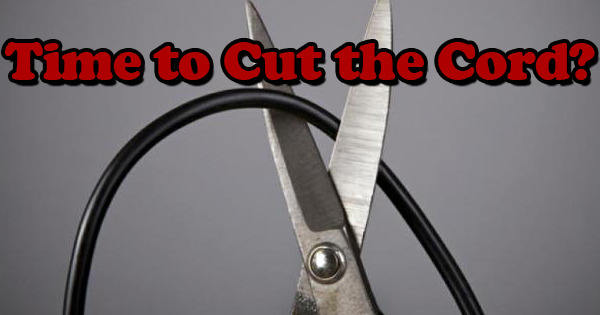
I don’t have to tell anyone that cable costs are skyrocketing. If there were shows on television worth watching, the bill wouldn’t be so hard to take. But, it appears that as we’re bombarded by more commercials and lame reality shows (my opinion – don’t send me angry e-mails), our bank accounts are under attack as well. More people are fed up with these charges and fees for services (channels) that they don’t even use than ever before, but is there another way? Is it truly possible to cut the cord and satisfy our entertainment needs at the same time? Let’s investigate.
In my town, we have four options for paid TV: Charter (cable), AT&T U-Verse (cable), DirecTV (satellite), or DISH Network (satellite). In the interest of full disclosure, at my house we have DirectTV (after dumping Charter) for television, and Charter for Internet. As a sports fan, I need to keep satellite TV. There are too many live events that I’d be missing if I were to drop my TV service entirely and only keep Internet and phone. The easiest way to save cash with your cable or satellite provider is to drop selected premium channels, or reduce your package (number of channels) to a lesser package. I’m not sure about others, but DirecTV offers a referral service. If a friend or family member signs up with DirecTV, they can give your name at the time of sign up, and you and the person who referred you will receive $10 off your bill per month for ten months. That might be worth looking into with your own plan.
Earlier, I mentioned reducing your premium channels. Premium channels are typically movie channels like HBO, Showtime, etc. Most people aren’t willing to give up movies entirely, so there needs to be an alternative. Netflix is one alternative. Amazon Prime Instant Video is another. With an Internet connection, you can stream (download) movies to any device in your home. The trick is getting your television connected to the Internet so you can enjoy these movies in all of their high definition splendor. Do you own a SmartTV? If so, it can (and should) be connected to your wireless Internet. If you’re not sure, or would like more information, read our post, “What Makes a Smart TV Smart, Anyway?” If you know your TV definitely isn’t smart, you can rectify that with a Roku. A Roku is a device that essentially turns any old TV into a Smart TV. For $66 from Amazon.com, you can simply plug one end of an HDMI cable into the Roku, and the other end into your television. Then plug the supplied power cable into the wall and your Roku and television will have access to the Internet. Roku currently offers over 3500 channels which can be downloaded (mostly for free) from the Roku Channel store. While you can download the Netflix channel (app) for free, for instance, you’ll need to have an active subscription to view content on your TV. Subscriptions range from $7.99 to $11.99 per month. It’s important to mention that you’ll need an Internet package with a decent speed in order to view streaming video without interruption. You’ll need at least 5 Megabits per second for HD video, and upwards of 25 Megabits per second for Ultra HD quality. Oh, by the way, HBO offers its own app in the Roku Channel Store.
As you can see, at this time it’s difficult at best to save a lot of money by cutting the cord. It’s impossible to outline all of the streaming devices and apps in the marketplace in this post – this is a Blog not a novel after all. In theory, an HD antenna CAN allow you to view some television for free, but here in the suburbs you might get a Spanish channel with a lot of interference if you’re lucky. The industry is heading in a direction of more streaming and “pay-per-view” type options, so don’t lose all hope for the future. For now, save where you can and watch what you want!
